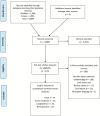Prevalence of Catatonia and Its Moderators in Clinical Samples: Results from a Meta-analysis and Meta-regression Analysis
- PMID: 29140521
- PMCID: PMC6101628
- DOI: 10.1093/schbul/sbx157
Prevalence of Catatonia and Its Moderators in Clinical Samples: Results from a Meta-analysis and Meta-regression Analysis
Abstract
Catatonia is an independent syndrome that co-occurs with several mental and medical conditions. We performed a systematic literature review in PubMed/Scopus until February 2017 and meta-analyzed studies reporting catatonia prevalence. Across 74 studies (cross-sectional = 32, longitudinal = 26, retrospective = 16) providing data collected from 1935 to 2017 across all continents, mean catatonia prevalence was 9.0% (k = 80, n = 110764; 95% CI = 6.9-11.7, I2 = 98%, publication bias P < .01), decreasing to 7.8% (k = 19, n = 7612, 95% CI = 7-8.7, I2 = 38.9%) in a subgroup with low heterogeneity. Catatonia prevalence was 23.9% (k = 8, n = 1168, 95% CI = 10-46.9, I2 = 96%) in patients undergoing ECT/having elevated creatinine phosphokinase. Excluding ECT samples, the catatonia prevalence was 8.1% (k = 72, n = 109606, 95% CI = 6.1-10.5, I2 = 98%, publication bias P < .01), with sensitivity analyses demonstrating that country of study origin (P < .001), treatment setting (P = .003), main underlying condition (P < .001), and sample size (P < .001)moderated catatonia prevalence, being highest in Uganda (48.5%, k = 1) and lowest in Mexico (1.9%, 95% CI = 0.4-8.8, I2 = 67%, k = 2), highest in nonpsychiatric out- or inpatient services (15.8%, 95% CI = 8.1-28.4, I2 = 97%, k = 15)and lowest in psychiatric outpatients services (3.2%, 95% CI = 1.7-6.1, I2 = 50%, k = 3), highest in presence of medical or neurological illness with no comorbid psychiatric condition (20.6%, 95% CI = 11.5-34.2, I2 = 95%, k = 10)and lowest in mixed psychiatric samples (5.7%, 95% CI = 4.2-7.7, I2 =98%, k = 43), highest in studies with sample sizes <100 (20.7%, 95% CI = 12.8-31.6, I2 = 90%, k = 17) and lowest in studies with sample sizes >1000 (2.3%, 95% CI = 1.3-3.9, I2 = 99%, k = 16). Meta-regression showed that smaller sample size (P < .01) and less major depressive disorder (P = .02) moderated higher catatonia prevalence. Year of data collection did not significantly moderate the results. Results from this first meta-analysis of catatonia frequencies across time and disorders suggest that catatonia is an epidemiologically and clinically relevant condition that occurs throughout several mental and medical conditions, whose prevalence has not decreased over time and does not seem to depend on different rating scales/criteria. However, results were highly heterogeneous, calling for a cautious interpretation.
Figures
References
-
- Fornaro M. Catatonia: a narrative review. Cent Nerv Syst Agents Med Chem. 2011;11:73–79. - PubMed
-
- Brenner I, Rheuban WJ. The catatonic dilemma. Am J Psychiatry. 1978;135:1242–1243. - PubMed
-
- Bush G, Fink M, Petrides G, Dowling F, Francis A. Catatonia. I. Rating scale and standardized examination. Acta Psychiatr Scand. 1996;93:129–136. - PubMed
-
- Fink M, Taylor MA. The many varieties of catatonia. Eur Arch Psychiatry Clin Neurosci. 2001;251(suppl 1):I8–I13. - PubMed
Publication types
MeSH terms
Grants and funding
LinkOut - more resources
Full Text Sources
Other Literature Sources
Medical




